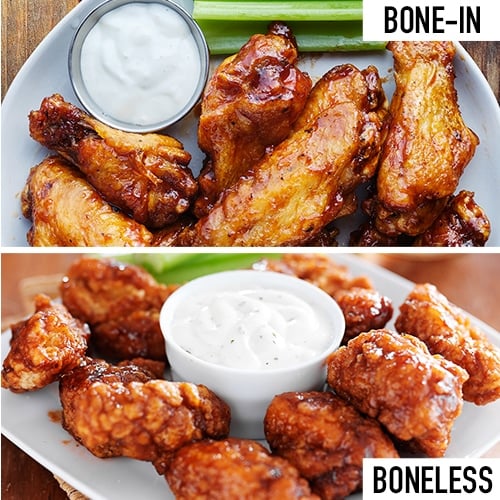What Are Boneless Wings?
Last updated on Aug 12, 2024Corrinn McCauleyBoneless wings are a happy hour menu staple, but if you pause long enough between crispy, juicy bites, you realize that a wing without a bone is an oxymoron. So, are boneless wings actually wings? Boneless wings are not chicken wings with their bones removed. They’re pieces of breast meat cut into the shape of chicken wings that chefs carefully bread, deep-fry, and slather in hot sauce. Discover everything you need to know about your favorite wing impersonator so you can serve them as a game day special.
Shop All Chicken WingsAre Boneless Wings Chicken Nuggets?

Boneless wings and chicken nuggets are both made from chicken breast meat, but they are not the same thing. Chicken nuggets are made from ground breast meat formed into bite-sized cubes, battered, and fried. Restaurants usually serve nuggets with dipping sauces on the side. In contrast, boneless chicken wings are diced or cubed pieces of unground chicken breast that are battered, fried, and doused in classic chicken wing sauces.
Are Chicken Wings White Meat or Dark?
Chicken wing meat is composed of mostly white muscle fibers and is classified as white meat. However, chicken wing meat has a 3.5% fat content, and breast meat has a fat content of just 1.25%. While chicken wings are more rich than other white meat cuts, they are still leaner than thigh meat. Thigh meat is approximately 4% fat content.
Boneless vs Bone In Wings
Chicken wings are a beloved food that travels well for delivery, so they’ve become the bread and butter of many virtual restaurant brands. As you evaluate whether you want to offer boneless or bone-in wings, consider the following factors:

- Cost - Boneless wings are more affordable and can help your restaurant cut costs during periods of high inflation. Their lower price point will also appeal to consumers.
- Prep-time - Without the skin, boneless wings cook faster than bone-in wings. However, there are other factors to consider. Boneless wings are prone to drying out and require greater attention to detail, which is difficult if you're experiencing staffing shortages. To keep them flavorful and moist, many operators brine their boneless wing meat, which requires prep time.
- Demand - According to an NPD study “The Chicken Wing Dilemma”, servings of bone-in wings have gone up by 6% while boneless wing sales have gone down by approximately 6%. Over 60% of restaurant wings are bone-in.
- Clean-up - If you’re catering a championship football game, boneless wings require less clean-up since there are no bones to throw away. Whether you’re staying to serve the wings at the event, or the patron is on their own to clean up, boneless and messless has its appeal.
Are Bone In or Boneless Wings Healthier?
Boneless wings appear healthier than bone-in varieties because they’re made of lean chicken breast meat and don’t contain high-fat chicken skin. However, cooks compensate for the lack of skin by battering their boneless wing meat to create the crunch consumers crave. Most bone-in wings are not breaded, making them a low-carb and gluten-free food. If you fry your bone-in wings in an allergen-friendly fryer, they can help you accommodate people with alternative diets.
Unfortunately, boneless wing meat is often mixed with unhealthy additives. Many operators add sodium phosphate to their boneless chicken wings to keep them moist. While it is considered safe, sodium phosphate is problematic if you need to reduce your sodium consumption, have high blood pressure, or suffer from kidney issues.
Other common boneless chicken wing additives are emulsifiers like propylene glycol alginate, xanthan gum, and guar gum. You may also find flavoring agents mixed into the breast meat. If you’re looking for healthier menu items, avoid boneless wings that list transglutaminase as an ingredient. Transglutaminase bonds proteins together, so if it's an ingredient in your boneless wings, they are composed of a mishmash of different chicken parts and are not cubed pieces of chicken breast.
Are Boneless Wings More Expensive?
Boneless wings are less expensive than true chicken wings. Each chicken only supplies four wings (two drumettes and two flats), so there is a disparity between supply and demand. Boneless wings are made from chicken breast meat, making them easier and cheaper to produce in bulk.

How Do They Make Boneless Wings?
Chefs make boneless wings by cutting boneless, skinless chicken breasts into wing-sized pieces, breading or battering them, and then deep frying them until golden brown.
How to Debone Chicken Wings
While the boneless chicken wings most restaurants serve are not deboned chicken, that doesn’t mean you can’t set your menu apart by serving deboned chicken wings. Follow these simple steps to debone chicken wings and offer the succulent flavors of bone-in wings without the messy aftermath.
- Remove any extra cartilage.
- Grab a bone and twist it a few times.
- Once the bone is loose, pull it out.
- Repeat this process for the second bone.
While their name is misleading, boneless wings are an economical alternative to traditional wings. If the meat isn’t loaded with unhealthy additives, then boneless wings are a reduced-fat alternative to classic wings that can appeal to health-conscious consumers. Whichever type of wings you decide to serve, up your flavor game by pairing them with your house-made sauces.



